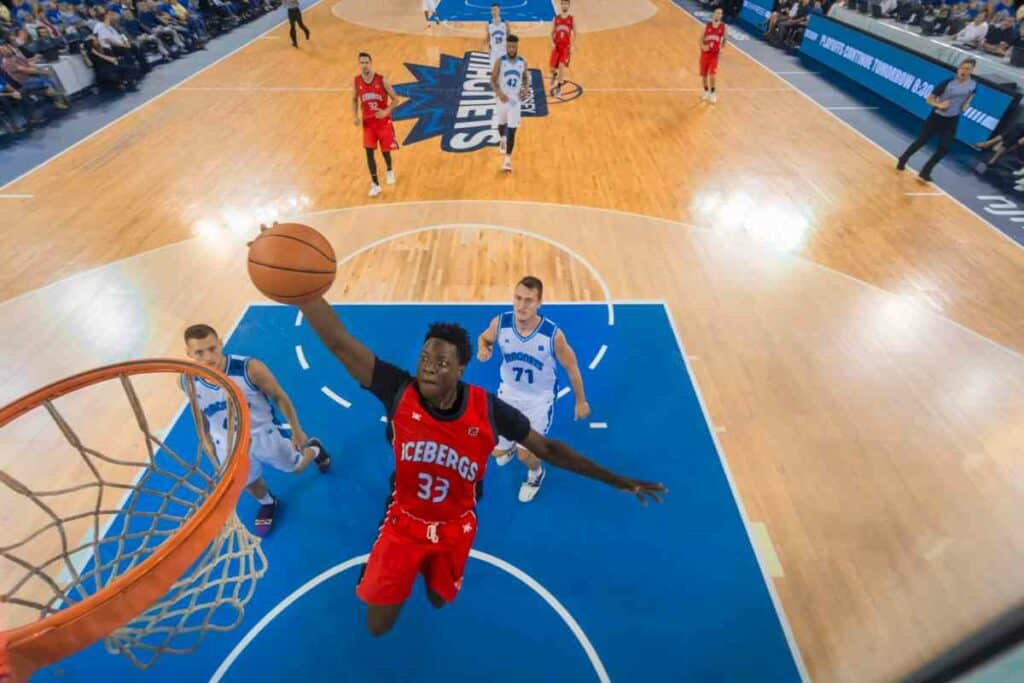How Long are College Basketball Quarters? Understanding Game Duration
Ever wondered why college basketball feels different from the NBA or international games? It’s all in the timing! If you’re a fan or a newcomer to the sport, understanding the structure of college basketball is key to enjoying the game to its fullest.

Related Post! How Many College Basketball Players Make The Cut?
How Long Are College Basketball Quarters?
College basketball games differ in structure between men’s and women’s formats. Men’s games consist of two 20-minute halves, not quarters. In contrast, women’s college basketball features four quarters, each lasting 10 minutes. This structure aligns women’s college basketball more closely with international and professional women’s leagues.
Key Takeaways for College Basketball Fans
- Men’s Games: Two halves, each 20 minutes.
- Women’s Games: Four quarters, each 10 minutes.
- The timing affects game strategy and aligns women’s games with international rules.
Men’s vs. Women’s College Basketball: A Timing Twist
In the NCAA, men’s games are uniquely structured into two 20-minute halves, unlike the NBA’s 12-minute quarters. But here’s an interesting twist: since 2015, NCAA women’s basketball adopted a four-quarter format, each lasting 10 minutes, to enhance game flow and align with international standards.

Why the Difference?
This shift for women’s college basketball wasn’t just a random change. It was a strategic move to improve the game’s dynamics and create a closer connection with the global basketball community. For men, the traditional two-half format continues to offer its own strategic depth.
Halftime and Breaks: Catching Your Breath
In men’s games, there’s a 15-minute halftime for players to rest and coaches to strategize. Women’s games, on the other hand, feature shorter breaks between quarters. These pauses are crucial for team huddles and quick rest.
Understanding the Game’s Pace
College basketball’s unique timing, with halves instead of quarters for men, sets it apart from the NBA’s four 12-minute quarters and high school basketball’s four 8-minute quarters. Even international games (FIBA) follow a four 10-minute quarter structure.
The Shot Clock: Keeping the Game Moving
The NCAA enforces a 30-second shot clock, striking a balance between the high school game’s longer clock and the NBA’s quicker 24-second clock. This ensures a lively pace throughout the game.
Overtime Dynamics
In the event of a tie, college basketball enters a thrilling 5-minute overtime. If needed, additional overtimes are played until a winner emerges, adding an extra layer of excitement.
By grasping these timing nuances, you’re now better equipped to appreciate the rhythms and strategies of college basketball. Whether you’re cheering for a men’s or women’s team, you’re in for a game full of strategic depth and excitement!
Historical Context of Game Time

Basketball’s journey through time, from its creation by Dr. James Naismith to its current global status, is a fascinating tale of evolution, especially in how the game is timed. Understanding this history not only enriches your appreciation of the sport but also highlights the diversity in game structures across different levels.
Basketball’s Early Days: A Point-Based Beginning
In 1891, when Dr. Naismith introduced basketball, the concept of game time was non-existent. Instead, matches were played until a team reached a specific point total. This format, however, evolved as the sport grew in popularity and organization, leading to the adoption of timed halves and quarters.
The College Basketball Journey: Halves to Quarters and Back Again
Initially, college basketball followed a two-half structure. Interestingly, it briefly experimented with four quarters, similar to high school basketball under the National Federation of State High School Associations (NFHS). Eventually, college basketball circled back to the two-half format, with each half lasting 20 minutes, a system that remains today.
High School Basketball: A Quarter-Based Approach
In high school basketball, the game is divided into four 8-minute quarters. This timing, standardized by the NFHS, is tailored for younger athletes, offering a shorter game duration compared to professional levels.
FIBA and International Play: A Global Standard
The International Basketball Federation (FIBA) oversees international competitions with a four-quarter, 10-minute each format. This structure is universally adopted for international games, establishing a consistent timing standard outside the United States.
Key Historical Milestones in Basketball Timing
- 1891: Dr. James Naismith invents basketball.
- 1912: NFHS establishes uniform game rules.
- 1950s: FIBA standardizes timing for international games.
- Present: College basketball uses halves; NFHS and FIBA use quarters.
Professional vs. Collegiate Basketball: Timing Differences
The game’s structure varies notably between professional leagues like the NBA and collegiate levels. These differences primarily lie in the length and regulation of playing time.
NBA League Time Regulations
In the NBA, games are longer, consisting of four 12-minute quarters, totaling 48 minutes of play. Overtime periods of 5 minutes are added as needed. This structure is designed for a high-energy, professional basketball experience.
Tournament Play: Consistency and Variation
During professional basketball tournaments, such as the NBA playoffs, the timing remains consistent with the regular season: four quarters of 12 minutes each. However, collegiate tournaments like those in the NCAA showcase a different approach, sticking to their unique two halves of 20 minutes. This distinction underscores the varied approaches to game timing across different levels of basketball.
A Global Sport with Diverse Timings
While the NBA and other professional leagues may vary in game length and structure, they all share a commitment to high-level competitive play. These events are significant in the basketball calendar, attracting large audiences and showcasing the sport’s global appeal.
Advanced Rules and Exceptions

College basketball, a realm of intense competition and strategy, is governed by specific regulations that shape the game’s duration and flow. These rules become even more pivotal during special tournaments and in managing foul-related scenarios.
Special Tournament Rules: The NCAA’s Unique Approach
During the high-stakes postseason, such as the NCAA tournament, the game format can shift from regular season norms. A notable example is the handling of overtime. In these critical matches, if a game remains tied after a standard five-minute overtime, additional overtimes are played until a winner is determined. This ensures a clear progression in the tournament bracket. Moreover, some tournaments experiment with rules like altering the possession arrow system, adding a layer of strategy to tiebreakers.
The Impact of Fouls on Game Dynamics
Fouls play a significant role in college basketball, influencing both game length and player dynamics:
- Player Fouls: A player is disqualified after accumulating five personal fouls, prompting teams to adapt their strategies and player rotations.
- Team Fouls: Once a team reaches seven fouls in a half, the opposing team is awarded free throws for non-shooting fouls. This bonus situation can significantly impact the game’s pace, especially in the second half.
Mastering Clock Management
As the game nears its end, particularly in the second half, clock management becomes a critical tactical element:
- 30-Second Shot Clock: Teams must attempt a shot within this timeframe, which resets under specific conditions like offensive rebounds.
- Timeouts: Coaches use timeouts to halt the clock and plan plays. Teams are typically allowed four timeouts in regulation, plus one additional for each overtime period.
- Last-Minute Fouling: Intentionally fouling to stop the clock and force free throws is a common tactic in close games, potentially shifting possession.
These nuanced rules add complexity to college basketball, extending the game beyond its official 40-minute duration and enriching its strategic depth.
The Role of Governing Bodies in Basketball Timing
Understanding basketball’s timing intricacies also involves recognizing the role of key organizations in establishing these rules.

NFHS: Shaping High School Basketball
The National Federation of State High School Associations (NFHS) plays a crucial role in defining high school basketball game durations in the U.S.:
- Quarters: 4
- Quarter Length: 8 minutes
- Governing Body: NFHS
The NFHS’s Basketball Rules Book is the cornerstone for high school basketball regulations, ensuring consistency across games.
FIBA: Standardizing International Basketball
The International Basketball Federation (FIBA) sets the timing rules for international basketball, differing from the NFHS:
- Halves: 2
- Half Length: 20 minutes
- Governing Body: FIBA
FIBA’s influence extends globally, impacting various levels of play outside the United States.
In summary, organizations like the NFHS and FIBA are instrumental in maintaining the structure and evolution of basketball, including critical aspects of game timing. Their rules and regulations not only ensure fairness and consistency but also adapt to the sport’s changing landscape.
Frequently Asked Questions
Understanding the timing structure of college basketball is essential to enjoy the game and appreciate the strategy behind it.
What is the duration of a men’s college basketball half?
In men’s NCAA basketball, each half is 20 minutes long, making the total regulation time 40 minutes.
Are college basketball games divided into halves or quarters?
Men’s college basketball games are divided into two halves, while women’s games are played in four quarters.
What is the length of each quarter in women’s NCAA basketball?
Each quarter in women’s NCAA basketball is 10 minutes long, totaling 40 minutes of game time.
How does the structure of college basketball periods differ from the NBA?
The NBA plays four 12-minute quarters totaling 48 minutes, which differs from NCAA women’s four 10-minute quarters and men’s two 20-minute halves.
How many periods are there in a standard NCAA men’s basketball game?
There are two periods, known as halves, in a standard NCAA men’s basketball game.
What is the total game time for a women’s college basketball match?
A standard women’s college basketball game consists of four quarters, each 10 minutes, totaling 40 minutes of playtime.
